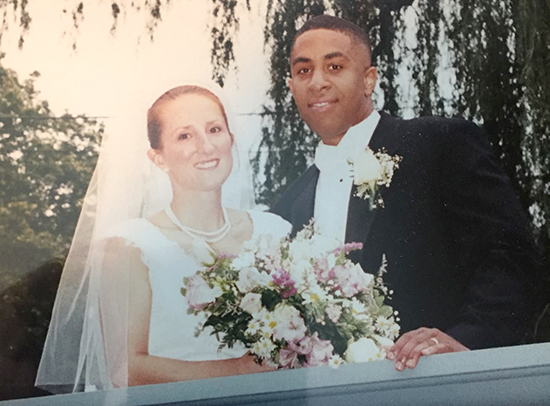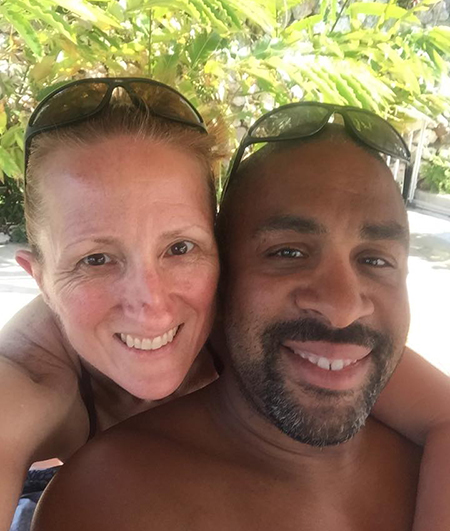
Luanne Tinnen and Clyde Tinnen on their wedding day in July 2000. Advice received in pre-marriage counseling has other practical applications.
At the end of July, my wife and I celebrated our 18th wedding anniversary. Day 6,570 of our marriage was pretty uneventful. My wife and I met friends for a couple of drinks in the Third Ward. We had pizza for dinner and watched one of our sons win two summer league basketball games late that evening. All in all, it was a nice anniversary.
As I reflect on our marriage, I often reminisce about all the great advice we received before our nuptials. Family, friends, coworkers, and casual acquaintances were all willing to give us unsolicited advice about what it would take to successfully tie the knot and stay together.
The most interesting piece of advice that we received came from the priest who officiated at our wedding. Ironically, this advice has also proven itself to be invaluable in my professional life as a mergers and acquisitions attorney.
Our priest imparted his wisdom to us during our Pre-Cana training. Pre-Cana is a course taught over five or six months for couples preparing to be married in a Catholic church. Father Tom Lynch, the pastor of our church at that time, presided over Pre-Cana along with a few long-married couples from the church.
Marital Discernment Instruction
During one of the sessions, we explored the enigmatic question of how one knows that he or she is marrying the right person. I admit that this question surprised me. It was asked during one of the latter sessions of Pre-Cana when, one would hope, all the engaged couples were long past this most basic of questions.
 Clyde Tinnen, Columbia 2006, is a partner with global law firm Withers LLP, and lives in Brookfield. He focuses his practice on corporate law matters, including finance and securities law, banking, private equity, and mergers and acquisitions.
Clyde Tinnen, Columbia 2006, is a partner with global law firm Withers LLP, and lives in Brookfield. He focuses his practice on corporate law matters, including finance and securities law, banking, private equity, and mergers and acquisitions.
After providing an overview of the question to be explored during the evening, Father Tom followed up with a statement I will never forget, which was even more surprising than the topic. He said, “Well, all of you must know by now that you never really know more than half of a person.” Huh? I knew (and know) more about Luanne than any other person in my life. What did he mean by half of a person? I must have had a look of incredulity all over my face.
Father Tom then proceeded to illustrate his premise with a drawing on a white board similar to the accompanying chart. [See chart, How to Know More Than Half a Person.]
As Father Tom explained, an engaged person’s knowledge of their soon-to-be spouse is always confined to Quadrant 1 and Quadrant 2 information. Quadrant 1 included my wife’s beautiful outward appearance and classy style of dress, but it also included her observable habits and public information about her work and association with various organizations, as well as any information that she posts on social media.
Quadrant 2 included all the things below the surface that she willingly shared with me during the two years that we dated, such as her memories (good and bad), fears, goals, dreams, and general outlook on life. Although our knowledge about one another would be limited to Quadrant 1 and Quadrant 2, Father Tom implored us not to despair; the key to this time of discernment was not to be discouraged by the things that we did not (and would not) know about each other but to be disciplined and diligent in analyzing the things that we did (and could) know about each other.
In other words, if we invested substantial time and effort understanding Quadrant 1 and Quadrant 2, we could minimize the scope of information in Quadrant 3 and we would be positioned well as a couple to approach Quadrant 4 with a common understanding of our values and a shared sense of faith and optimism about our ability as a couple to cope with the unknown.
As it turns out, Father Tom was spot on and I am grateful for the framework that he provided because it gave me a great sense of confidence in Luanne and our decision to wed before we walked down the aisle. What I did not appreciate at the time was that Father Tom’s pre-wedding warning would also be the rubric that I use when helping my clients to evaluate potential mergers and acquisitions.

Clyde Tinnen and his wife, Luanne, recently celebrated their 18th wedding anniversary. Knowing more than half a person (or organization) contributes to long relationships.
“Marriages” of Organizations
As the name would suggest, mergers and acquisitions are actually two distinct types of transactions. A merger is the combination of two or more entities (for example, corporations, partnerships, LLCs) to form a single new legal entity. An acquisition is the purchase of one company by another company, which typically means purchasing the assets or the stock or equity of the acquired company.
Mergers and acquisitions (M&A) are very similar to a marriage in some respects. The common theme of “two becoming one” is ever present in both marriage and M&A. Accordingly, company owners and managers are extremely anxious about choosing the right merger partner or acquiring the right business. If they choose wisely, the business can grow and prosper for many years to come. If they choose unwisely, the business could fail or be saddled with debt or other liabilities. As I often remind my clients, sometimes the best transaction is the transaction that you do not do at all.
I find it very helpful to use the marital discernment rubric when conducting M&A due diligence. The rubric (as adapted and supplemented for business purposes) is further described below.
How to Know More Than Half a Person
|
Quadrant 1: Conspicuous Facts –
Things the whole world can see or find out about your future spouse.
|
Quadrant 2: Revelations –
Things your future spouse chooses to share with you.
|
|
Quadrant 3: Guarded Secrets –
Things your future spouse chooses not to share with you.
|
Quadrant 4: Unknowable –
Things that your future spouse does not presently know about himself or herself or that do not manifest until the future.
|
Quadrant 1 - Conspicuous Facts
A plethora of public information is available about businesses and industries, big and small. Google is always a great starting place but there are numerous other free public sources of information, including the company website, the U.S. Securities and Exchange Commission (www.sec.gov), Wisconsin Circuit Court Access (https://wcca.wicourts.gov/), the Wisconsin Department of Financial Institutions (www.wdfi.org/corporations/), the U.S. Patent and Trademark Office (www.uspto.gov), industry and trade association websites, social media (for example, LinkedIn) and the Better Business Bureau (www.bbb.org/wisconsin).
If the M&A partner refuses to discuss certain matters or is not willing to provide representations and warranties about critical matters, this can be a tell-tale sign that there is not a good fit.
It is crucial to conduct thorough research about your potential M&A partner and its reputation in the industry. It is also important to review publicly available information about the principals of the business to understand their reputations.
I strongly encourage my clients to thoroughly assess publicly available information before engaging lawyers, bankers, and accountants to get involved, for two reasons. First, it is more cost-effective to avoid engaging third parties prematurely. Second, public research can reveal immediate disqualifiers for a potential target that can be flushed out early in the process.
Meet Our Contributors
Why do you do what you do? What's the best advice you ever received? Share your weirdest courtroom story...
Lawyers have a lot to say. Our authors are no exception. Whether its personal, insightful, or fun, it’s always interesting.
Check out our Q&A with the author below
Quadrant 2 - Revelations
After you have initiated conversations with your potential M&A partner, the formal courting process begins. Your M&A partner will request that you sign a confidentiality agreement to confirm that you will not disclose sensitive proprietary information or use the partner’s information to its detriment.
After the confidentiality agreement is signed, typically the acquirer will provide the potential M&A partner with a due diligence request list. These lists can be 20-30 pages long and intimidating for the individuals who receive them. However, the importance of requesting everything under the sun cannot be overstated. The typical list will include requests for financial statements and forecasts, organizational documents, material contracts, environmental contingencies, intellectual property, real property leases and ownership records, debt and equity agreements, employee benefits documents, union agreements, insurance coverage, and litigation and notices regarding legal and regulatory compliance issues.
I strongly encourage my clients to thoroughly assess publicly available information before engaging lawyers, bankers, and accountants to get involved.
The review of the due diligence responses is the starting point for discussions about the company’s past and future prospects. If reviewing the diligence materials has not scared the buyer away, then the buyer will prepare a purchase agreement or merger agreement that includes specific representations and warranties by the selling M&A partner that memorialize the validity of what has been revealed during this due diligence. The representations, or assertions as to the facts on the topics discussed, form the basis for a warranty, or a promise of indemnity (buyer protection against a loss or other financial burden), if the representation is false.
Again, if the M&A partner refuses to discuss certain matters or is not willing to provide representations and warranties about critical matters, this can be a tell-tale sign that there is not a good fit.
Quadrant 3 - Guarded Secrets
Just as with marital discernment, the objective when evaluating a possible M&A partner is to invest substantial time and effort understanding Quadrant 1 and Quadrant 2, to minimize the scope of information potentially in Quadrant 3. It is important when drafting a purchase agreement or merger agreement that the potential M&A partner bear the risk and liability of matters that are intentionally not disclosed.
Often clients assume that intentionally hiding the ball is fraud per se; however, it is very difficult from an evidentiary standpoint to prove fraudulent intention. Accordingly, it is better to rely on failure to satisfy a contractual obligation to disclose than to sue the M&A partner for fraud.
Quadrant 4 - Unknowable
Just as with marriage, there is no crystal ball. Life and economic downturns do happen. When you have done all that you can begin to fully understand the knowable half of the M&A partner, the prospects for the business and industry, then there is little room for regret and second guessing. Once you have jumped the broom, it is important to muster up your faith and optimism about the future and get down to the business of executing your business plan.
Meet Our Contributors
What’s the best career advice you ever received?
 One of the best pieces of advice that I ever received was from Quad/Graphics founder Harry Quadracci.
One of the best pieces of advice that I ever received was from Quad/Graphics founder Harry Quadracci.
Harry used to often say, “Dream big but think small.” My interpretation of this mantra was that we should all free ourselves to explore our dreams, goals, and ambitions in life without any of the limitations, anchors, or constraints that skepticism, self-doubt, or temporary obstacles might present; however, achieving our dreams, goals, and ambitions requires the focus, commitment, and discipline to make detailed plans and execute on those plans.
I could not agree more. I believe that history teaches us that all great achievements, such as man walking on the moon or the civil rights movement, have started with an idea or a dream that defied the then-present “reality,” but it has been the thoughtful and meticulous implementation of those ideas that has truly changed the world.
Clyde Tinnen, Withers LLP, Brookfield.
Become a contributor! Are you working on an interesting case? Have a practice tip to share? There are several ways to contribute to Wisconsin Lawyer. To discuss a topic idea, contact Managing Editor Karlé Lester at (800) 444-9404, ext. 6127, or email klester@wisbar.org. Check out our writing and submission guidelines.
